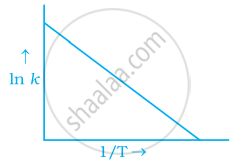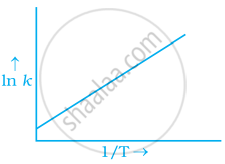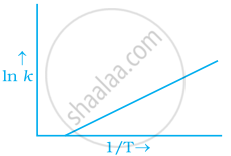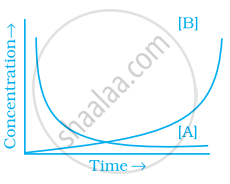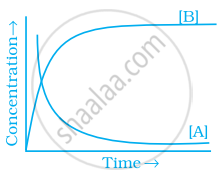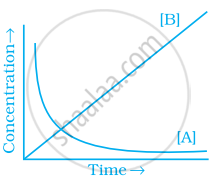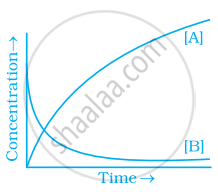Advertisements
Online Mock Tests
Chapters
2: Solutions
3: Electrochemistry
▶ 4: Chemical Kinetics
5: Surface Chemistry
6: General Principle and Processes of Isolation of Elements
7: The p-block Elements
8: The d-and f-Block Elements
9: Coordination Compounds
10: Haloalkanes and Haloarenes
11: Alcohols, Phenols and Ethers
12: Aldehydes, Ketones and Carboxylic Acids
13: Amines
14: Biomolecules
15: Polymers
16: Chemistry In Everyday Life
![NCERT Exemplar solutions for Chemistry [English] Class 12 chapter 4 - Chemical Kinetics NCERT Exemplar solutions for Chemistry [English] Class 12 chapter 4 - Chemical Kinetics - Shaalaa.com](/images/chemistry-english-class-12_6:5f2b1b2038084cf381bfa42c826a928c.jpg)
Advertisements
Solutions for Chapter 4: Chemical Kinetics
Below listed, you can find solutions for Chapter 4 of CBSE NCERT Exemplar for Chemistry [English] Class 12.
NCERT Exemplar solutions for Chemistry [English] Class 12 4 Chemical Kinetics Exercises [Pages 47 - 59]
Multiple Choice Questions (Type - I)
The role of a catalyst is to change ______.
gibbs energy of reaction.
enthalpy of reaction.
activation energy of reaction.
equilibrium constant.
In the presence of a catalyst, the heat evolved or absorbed during the reaction ______.
increases.
decreases.
remains unchanged.
may increase or decrease
Activation energy of a chemical reaction can be determined by ______.
determining the rate constant at standard temperature.
determining the rate constants at two temperatures.
determining probability of collision.
using catalyst.
Consider figure and mark the correct option.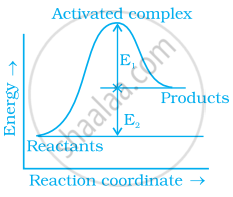
Activation energy of forward reaction is E1 + E2 and product is less stable than reactant.
Activation energy of forward reaction is E1 + E2 and product is more stable than reactant.
Activation energy of both forward and backward reaction is E1 + E2 and reactant is more stable than product.
Activation energy of backward reaction is E1 and product is more stable than reactant.
Consider a first order gas phase decomposition reaction given below :
\[\ce{A(g) -> B(g) + C(g)}\]
The initial pressure of the system before decomposition of A was pi. After lapse of time ‘t’, total pressure of the system increased by x units and became ‘pt’ The rate constant k for the reaction is given as ______.
`k = 2.303/t log p_i/(p_i - x)`
`k = 2.303/t log p_i/(2p_i - p_t)`
`k = 2.303/t log p_i/(2p_i + p_t)`
`k = 2.303/t log p_i/(p_i + x)`
According to Arrhenius equation rate constant k is equal to `A e^((-Ea)/(RT)`. Which of the following options represents the graph of ln k vs `1/T`?
Consider the Arrhenius equation given below and mark the correct option.
`k = Ae^((-E_a)/(RT)`
Rate constant increases exponentially with increasing activation energy and decreasing temperature.
Rate constant decreases exponentially with increasing activation energy and decreasing temperature.
Rate constant increases exponentially with decreasing activation energy and decreasing temperature.
Rate constant increases exponentially with decreasing activation energy and increasing temperature.
A graph of volume of hydrogen released vs time for the reaction between zinc and dil.HCl is given in figure. On the basis of this mark the correct option.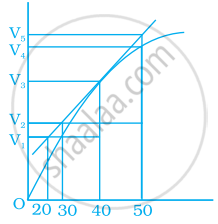
Average rate upto 40s is `(V_3 - V_2)/40`
Average rate upto 40 seconds is `(V_3 - V_2)/(40 - 30)`
Average rate upto 40 seconds is `V_3/40`
Average rate upto 40 seconds is `(V_3 - V_1)/(40 - 20)`
Which of the following statements is not correct about order of a reaction.
The order of a reaction can be a fractional number.
Order of a reaction is experimentally determined quantity.
The order of a reaction is always equal to the sum of the stoichiometric coefficients of reactants in the balanced chemical equation for a reaction.
The order of a reaction is the sum of the powers of molar concentration of the reactants in the rate law expression.
Consider the graph given in figure. Which of the following options does not show instantaneous rate of reaction at 40th second?

`("V"_5 - "V"_2)/(50 - 30)`
`("V"_4 - "V"_2)/(50 - 30)`
`("V"_3 - "V"_2)/(40 - 30)`
`("V"_3 - "V"_1)/(40 - 20)`
Which of the following statements is correct?
The rate of a reaction decreases with passage of time as the concentration of reactants dereases.
The rate of a reaction is same at any time during the reaction.
The rate of a reaction is independent of temperature change.
The rate of a reaction decreases with increase in concentration of reactant(s).
Which of the following expressions is correct for the rate of reaction given below?
\[\ce{5Br^- (aq) + BrO3^- (aq) + 6H^+ (aq) -> 3Br2 (aq) + 3H2O(l)}\]
`(∆["Br"^-])/(∆"t") = 5 (∆["H"^+])/(∆"t")`
`(∆["Br"^-])/(∆"t") = 6/5 (∆["H"^+])/(∆"t")`
`(∆["Br"^-])/(∆"t") = 5/6 (∆["H"^+])/(∆"t")`
`(∆["Br"^-])/(∆"t") = 6 (∆["H"^+])/(∆"t")`
Which of the following graphs represents exothermic reaction?
(a)
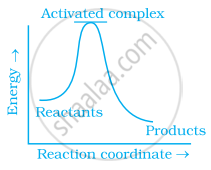
(b)
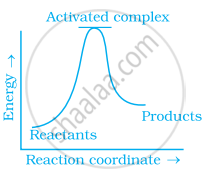
(c)
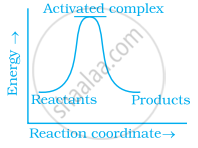
(a) only
(b) only
(c) only
(a) and (b)
Rate law for the reaction \[\ce{A + 2B -> C}\] is found to be Rate = k [A][B]. Concentration of reactant ‘B’ is doubled, keeping the concentration of ‘A’ constant, the value of rate constant will be ______.
the same
doubled
quadrupled
halved
Which of the following statements is incorrect about the collison theory of chemical reaction?
It considers reacting molecules or atoms to be hard spheres and ignores their structural features.
Number of effective collisions determines the rate of reaction.
Collision of atoms or molecules possessing sufficient threshold energy results into the product formation.
Molecules should collide with sufficient threshold energy and proper orientation for the collision to be effective.
A first order reaction is 50% completed in 1.26 × 1014 s. How much time would it take for 100% completion?
1.26 × 1015 s
2.52 × 1014 s
2.52 × 1028 s
infinite
Compounds ‘A’ and ‘B’ react according to the following chemical equation.
\[\ce{A(g) + 2B(g) -> 2C(g)}\]
Concentration of either ‘A’ or ‘B’ were changed keeping the concentrations of one of the reactants constant and rates were measured as a function of initial concentration. Following results were obtained. Choose the correct option for the rate equations for this reaction.
| Experiment | Initial concentration of [A]/mol L–¹ |
Initial concentration of [B]/mol L–¹ |
Initial rate of formation of [C]/mol L–¹ s–¹ |
| 1. | 0.30 | 0.30 | 0.10 |
| 2. | 0.30 | 0.60 | 0.40 |
| 3. | 0.60 | 0.30 | 0.20 |
Rate = k[A]2[B]
Rate = k[A][B]2
Rate = k[A][B]
Rate = k[A]2[B]0
Which of the following statement is not correct for the catalyst?
It catalyses the forward and backward reaction to the same extent.
It alters ∆G of the reaction.
It is a substance that does not change the equilibrium constant of a reaction.
It provides an alternate mechanism by reducing activation energy between reactants and products.
The value of rate constant of a pseudo first order reaction ______.
depends on the concentration of reactants present in small amount.
depends on the concentration of reactants present in excess.
is independent of the concentration of reactants.
depends only on temperature.
Consider the reaction A ⇌ B. The concentration of both the reactants and the products varies exponentially with time. Which of the following figures correctly describes the change in concentration of reactants and products with time?
Multiple Choice Questions (Type - II) Note: In the following questions two or more options may be correct.
Rate law cannot be determined from balanced chemical equation if:
(i) reverse reaction is involved.
(ii) it is an elementary reaction.
(iii) it is a sequence of elementary reactions.
(iv) any of the reactants is in excess.
Which of the following statements are applicable to a balanced chemical equation of an elementary reaction?
(i) Order is same as molecularity.
(ii) Order is less than the molecularity.
(iii) Order is greater than the molecularity.
(iv) Molecularity can never be zero.
In any unimolecular reaction:
(i) only one reacting species is involved in the rate determining step.
(ii) the order and the molecularity of slowest step are equal to one.
(iii) the molecularity of the reaction is one and order is zero.
(iv) both molecularity and order of the reaction are one.
For a complex reaction:
(i) order of overall reaction is same as molecularity of the slowest step.
(ii) order of overall reaction is less than the molecularity of the slowest step.
(iii) order of overall reaction is greater than molecularity of the slowest step.
(iv) molecularity of the slowest step is never zero or non interger.
At high pressure the following reaction is zero order.
\[\ce{2NH3(g) ->[1130 K][Platinum catalyst] N2(g) + 3H2(g)}\]
Which of the following options are correct for this reaction?
(i) Rate of reaction = Rate constant.
(ii) Rate of the reaction depends on concentration of ammonia.
(iii) Rate of decomposition of ammonia will remain constant until ammonia disappears completely.
(iv) Further increase in pressure will change the rate of reaction.
During decomposition of an activated complex:
(i) energy is always released
(ii) energy is always absorbed
(iii) energy does not change
(iv) reactants may be formed
According to Maxwell Boltzmann distributon of energy:
(i) the fraction of molecules with most probable kinetic energy decreases at higher temperatures.
(ii) the fraction of molecules with most probable kinetic energy increases at higher temperatures.
(iii) most probable kinetic energy increases at higher temperatures.
(iv) most probable kinetic energy decreases at higher temperatures.
In the graph showing Maxwell Boltzman distribution of energy:
(i) area under the curve must not change with increase in temperature.
(ii) area under the curve increases with increase in temperature.
(iii) area under the curve decreases with increase in temperature.
(iv) with increase in temperature curve broadens and shifts to the right hand side.
Which of the following statements are in accordance with the Arrhenius equation?
(i) Rate of a reaction increases with increase in temperature.
(ii) Rate of a reaction increases with decrease in activation energy.
(iii) Rate constant decreases exponentially with increase in temperature.
(iv) Rate of reaction decreases with decrease in activation energy.
Mark the incorrect statements:
(i) Catalyst provides an alternative pathway to reaction mechanism.
(ii) Catalyst raises the activation energy.
(iii) Catalyst lowers the activation energy.
(iv) Catalyst alters enthalpy change of the reaction.
Which of the following graphs is correct for a zero order reaction?
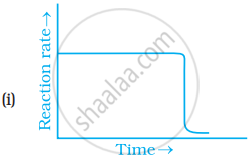
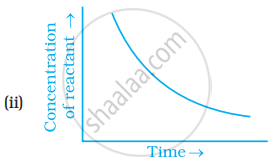
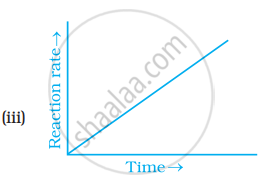

Which of the following graphs is correct for a first order reaction?

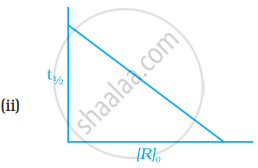
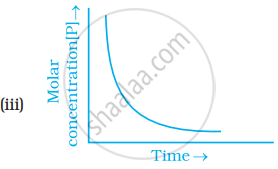
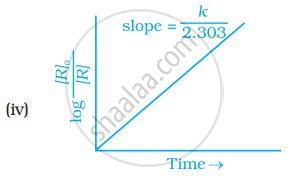
Short Answer Type
State a condition under which a bimolecular reaction is kinetically first order reaction.
Write the rate equation for the reaction `2A + B -> C` if the order of the reaction is zero.
How can you determine the rate law of the following reaction?
\[\ce{2NO(g) + O2(g) -> 2NO2(g)}\]
For which type of reactions, order and molecularity have the same value?
In a reaction if the concentration of reactant A is tripled, the rate of reaction becomes twenty seven times. What is the order of the reaction?
Derive an expression to calculate time required for completion of zero order reaction.
For a reaction A + B `->` Products, the rate law is — Rate = k [A][B]3/2 Can the reaction be an elementary reaction? Explain.
For a certain reaction large fraction of molecules has energy more than the threshold energy, yet the rate of reaction is very slow. Why?
For a zero order reaction will the molecularity be equal to zero? Explain.
For a general reaction A → B, plot of concentration of A vs time is given in figure. Answer the following question on the basis of this graph.
(i) What is the order of the reaction?
(ii) What is the slope of the curve?
(iii) What are the units of rate constant?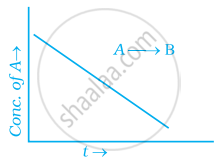
The reaction between \[\ce{H2(g)}\] and \[\ce{O2(g)}\] is highly feasible yet allowing the gases to stand at room temperature in the same vessel does not lead to the formation of water. Explain.
Why does the rate of a reaction increase with rise in temperature?
Oxygen is available in plenty in air yet fuels do not burn by themselves at room temperature. Explain.
Why is the probability of reaction with molecularity higher than three very rare?
Why does the rate of any reaction generally decreases during the course of the reaction?
Thermodynamic feasibility of the reaction alone cannot decide the rate of the reaction. Explain with the help of one example.
Why in the redox titration of \[\ce{KMnO4}\] vs oxalic acid, we heat oxalic acid solution before starting the titration?
Why can’t molecularity of any reaction be equal to zero?
Why molecularity is applicable only for elementary reactions and order is applicable for elementary as well as complex reactions?
Why can we not determine the order of a reaction by taking into consideration the balanced chemical equation?
Matching Type
Match the graph given in Column I with the order of reaction given in Column II. More than one item in Column I may link to the same item of Column II.
| Column I | Column II | |
| (i) | 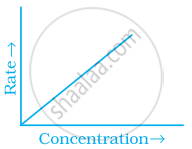 |
|
| (ii) | 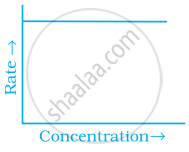 |
(a) 1st order |
| (iii) | 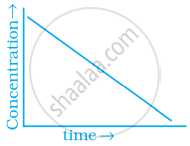 |
(b) Zero-order |
| (iv) |  |
Match the statements given in Column I and Column II
| Column I | Column I | |
| (i) | Catalyst alters the rate of reaction | (a) cannot be fraction or zero |
| (ii) | Molecularity | (b) proper orientation is not there always |
| (iii) | Second half life of first order reaction | (c) by lowering the activation energy |
| (iv) | `e^((-E_a)/(RT)` | (d) is same as the first |
| (v) | Energetically favourable reactions (e) total probability is one are sometimes slow | (e) total probability is one |
| (vi) | Area under the Maxwell Boltzman curve is constant | (f) refers to the fraction of molecules with energy equal to or greater than activation energy |
Match the items of Column I and Column II.
| Column I | Column II | |
| (i) | Diamond | (a) short interval of time |
| (ii) | Instantaneous rate | (b) ordinarily rate of conversion is imperceptible |
| (iii) | Average rate | (c) long duration of time |
Match the items of Column I and Column II.
| Column I | Column II | |
| (i) | Mathematical expression for rate of reaction | (a) rate constant |
| (ii) | Rate of reaction for zero order reaction is equal to | (b) rate law |
| (iii) | Units of rate constant for zero order reaction is same as that of | (c) order of slowest step |
| (iv) | Order of a complex reaction is determined by | (d) rate of a reaction |
Assertion and Reason Type Note: In the following questions a statement of assertion followed by a statement of reason is given. Choose the correct answer out of the following choices.
Assertion: Order of the reaction can be zero or fractional.
Reason: We cannot determine order from balanced chemical equation.
Both assertion and reason are correct and the reason is correct explanation of assertion.
Both assertion and reason are correct but reason does not explain assertion.
Assertion is correct but reason is incorrect.
Both assertion and reason are incorrect.
Assertion is incorrect but reason is correct.
Assertion: Order and molecularity are same.
Reason: Order is determined experimentally and molecularity is the sum of the stoichiometric coefficient of rate determining elementary step.
Both assertion and reason are correct and the reason is correct explanation of assertion.
Both assertion and reason are correct but reason does not explain assertion.
Assertion is correct but reason is incorrect.
Both assertion and reason are incorrect.
Assertion is incorrect but reason is correct.
Assertion: The enthalpy of reaction remains constant in the presence of a catalyst.
Reason: A catalyst participating in the reaction, forms different activated complex and lowers down the activation energy but the difference in energy of reactant and product remains the same.
Both assertion and reason are correct and the reason is correct explanation of assertion.
Both assertion and reason are correct but reason does not explain assertion.
Assertion is correct but reason is incorrect.
Both assertion and reason are incorrect.
Assertion is incorrect but reason is correct.
Assertion: All collision of reactant molecules lead to product formation.
Reason: Only those collisions in which molecules have correct orientation and sufficient kinetic energy lead to compound formation.
Both assertion and reason are correct and the reason is correct explanation of assertion.
Both assertion and reason are correct but reason does not explain assertion.
Assertion is correct but reason is incorrect
Both assertion and reason are incorrect.
Assertion is incorrect but reason is correct.
Assertion: Rate constants determined from Arrhenius equation are fairly accurate for simple as well as complex molecules.
Reason: Reactant molecules undergo chemical change irrespective of their orientation during collision.
Both assertion and reason are correct and the reason is correct explanation of assertion.
Both assertion and reason are correct but reason does not explain assertion.
Assertion is correct but reason is incorrect.
Both assertion and reason are incorrect.
Assertion is incorrect but reason is correct.
Long Answer Type
All energetically effective collisions do not result in a chemical change. Explain with the help of an example.
What happens to most probable kinetic energy and the energy of activation with increase in temperature?
Describe how does the enthalpy of reaction remain unchanged when a catalyst is used in the reaction.
Explain the difference between instantaneous rate of a reaction and average rate of a reaction.
With the help of an example explain what is meant by pseudo first order reaction.
Solutions for 4: Chemical Kinetics
![NCERT Exemplar solutions for Chemistry [English] Class 12 chapter 4 - Chemical Kinetics NCERT Exemplar solutions for Chemistry [English] Class 12 chapter 4 - Chemical Kinetics - Shaalaa.com](/images/chemistry-english-class-12_6:5f2b1b2038084cf381bfa42c826a928c.jpg)
NCERT Exemplar solutions for Chemistry [English] Class 12 chapter 4 - Chemical Kinetics
Shaalaa.com has the CBSE Mathematics Chemistry [English] Class 12 CBSE solutions in a manner that help students grasp basic concepts better and faster. The detailed, step-by-step solutions will help you understand the concepts better and clarify any confusion. NCERT Exemplar solutions for Mathematics Chemistry [English] Class 12 CBSE 4 (Chemical Kinetics) include all questions with answers and detailed explanations. This will clear students' doubts about questions and improve their application skills while preparing for board exams.
Further, we at Shaalaa.com provide such solutions so students can prepare for written exams. NCERT Exemplar textbook solutions can be a core help for self-study and provide excellent self-help guidance for students.
Concepts covered in Chemistry [English] Class 12 chapter 4 Chemical Kinetics are Zero Order Reactions, Rate of Chemical Reaction, Integrated Rate Equations, Factors Influencing Rate of a Reaction, First Order Reactions, Half Life Period of a Reaction, Pseudo First Order Reaction, Temperature Dependence of the Rate of a Reaction, Collision Theory of Chemical Reactions, Effect of Catalyst on the Rate of Reaction, Kinetic Energy of Molecule, Role of Catalyst, Rate Law and Specific Rate Constant.
Using NCERT Exemplar Chemistry [English] Class 12 solutions Chemical Kinetics exercise by students is an easy way to prepare for the exams, as they involve solutions arranged chapter-wise and also page-wise. The questions involved in NCERT Exemplar Solutions are essential questions that can be asked in the final exam. Maximum CBSE Chemistry [English] Class 12 students prefer NCERT Exemplar Textbook Solutions to score more in exams.
Get the free view of Chapter 4, Chemical Kinetics Chemistry [English] Class 12 additional questions for Mathematics Chemistry [English] Class 12 CBSE, and you can use Shaalaa.com to keep it handy for your exam preparation.
